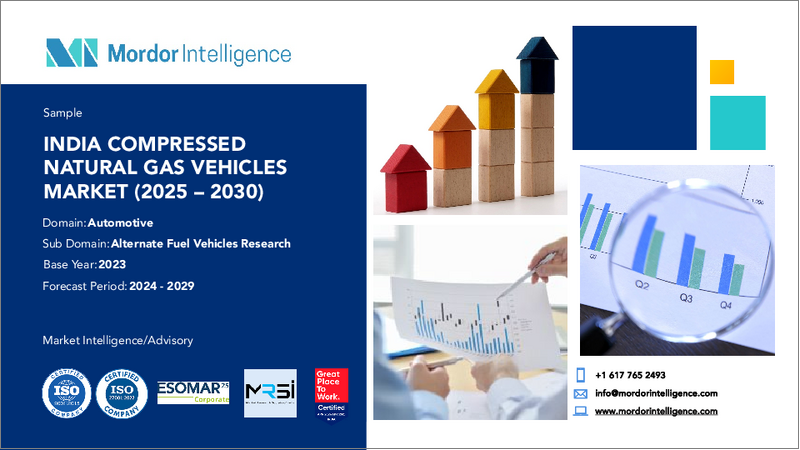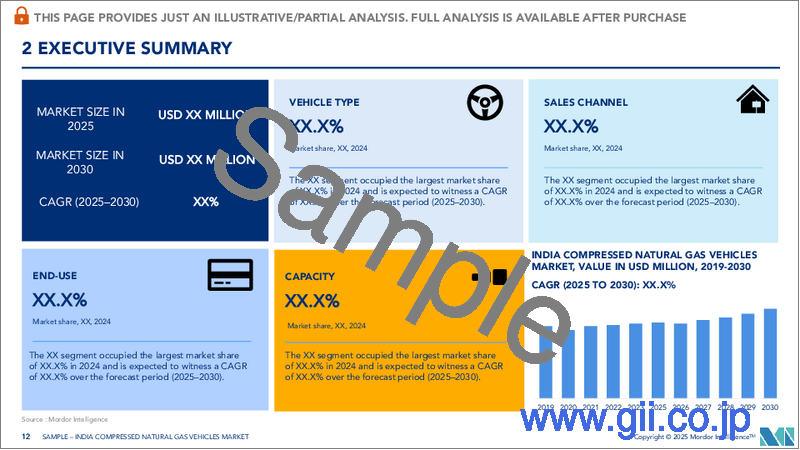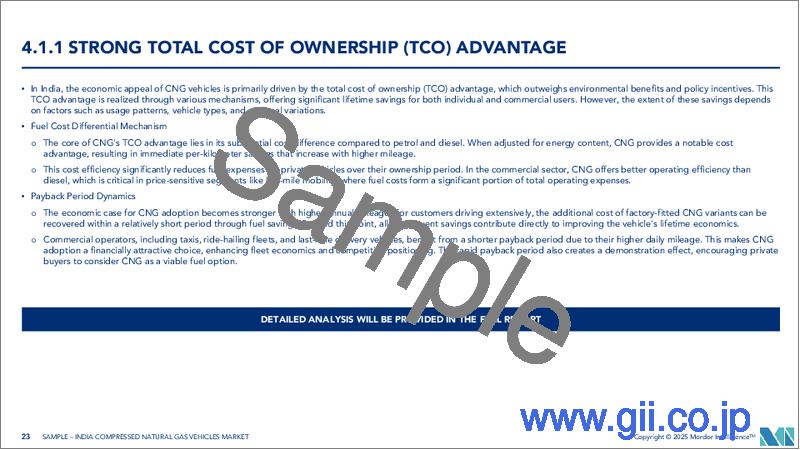|
|
市場調査レポート
商品コード
1693630
インドのCNG車市場:市場シェア分析、産業動向・統計、成長予測(2025年~2030年)India CNG Vehicles - Market Share Analysis, Industry Trends & Statistics, Growth Forecasts (2025 - 2030) |
||||||
カスタマイズ可能
適宜更新あり
|
|||||||
| インドのCNG車市場:市場シェア分析、産業動向・統計、成長予測(2025年~2030年) |
|
出版日: 2025年03月18日
発行: Mordor Intelligence
ページ情報: 英文 187 Pages
納期: 2~3営業日
|
全表示
- 概要
- 目次
インドのCNG車市場規模は2025年に103億8,000万米ドルと推定・予測され、2029年には135億5,000万米ドルに達し、予測期間中(2025~2029年)のCAGRは6.88%で成長すると予測されます。

インド政府は、従来の燃料に代わる費用対効果が高くクリーンな代替燃料の必要性から、CNG車を導入しています。
- インドのCNG圧縮天然ガス(圧縮天然ガス)車への移行は、環境持続可能性の向上とコスト効率の最適化という2つの目標に後押しされた、自動車・運輸業界における重要な変化を浮き彫りにしています。CNGは、乗用車から商用トラックやバスに至るまで、さまざまなセグメントで実行可能な代替燃料として台頭しており、二酸化炭素排出量と従来の化石燃料への依存を減らすという国の取り組みを反映しています。
- 乗用車分野、特にハッチバック車では、完全電動化へのシフトを示す若干の減少が予想されるもの、CNG車の需要は、その費用対効果と低排出ガスに牽引され、引き続き増加しています。小型商用車、中型トラック、大型トラックを含む商用車セクターでは、CNGの採用が堅調に伸びています。この動向は、環境政策、ディーゼルよりもCNGの方が経済的メリットがあること、CNG燃料補給インフラが拡大していることなどに後押しされています。この成長軌道は、補助金、CNGインフラの開発、厳しい排ガス規制を通じてよりクリーンな輸送を促進する政府のイニシアチブによって支えられています。
- さらに、バス部門では、CNGは都市交通の持続可能性を高めるための重要な要素であると考えています。規制当局の支援と環境ニーズの最前線により、CNGバスはインドの公共交通網の要となり、ディーゼルバスに代わるよりクリーンで経済的な代替手段を提供することになります。インドがCNG技術を進歩させ、燃料補給インフラを拡大し続けるにつれて、あらゆるセグメントのCNG車市場が持続的に成長する態勢が整っています。
インドのCNG車市場動向
インドの自動車金利は、RBIの措置と融資慣行の進化に牽引され、一貫した低下傾向を示しています。
- 最近のインドの自動車金利は約8.567%で、2021年に観測された8.698%から低下しています。この約1.5%というわずかな低下は、2019年の9.15%から2021年の8.698%まで金利が低下した前年の傾向を引き継いでいます。こうした動きを支える要因には、インド準備銀行(RBI)による金融政策決定、国内の信用需要、より広範なマクロ経済状況が含まれる可能性があります。
- 2017年から2023年にかけて、インドの自動車金利は9.508%で観測されました。その後の数年間、金利はわずかな変動を経験し、2018年には9.454%までわずかに低下し、2019年には9.466%までわずかに上昇しました。しかし、2019年以降はより大幅な下落が観察され、2022年には8.567%となりました。RBIからの報告によると、こうした変化は、金融緩和策、融資慣行の進化、世界の大流行などの課題に直面して経済成長を強化しようとする試みの組み合わせに起因する可能性があります。
- インドの自動車金利に関する最近の動向分析では、今後数年間は相対的に低金利の傾向が続くと予想されています。2022年に8.567%まで低下する現在の金利は、2019年の9.15%からの低下を基礎としており、経済成長を刺激するためのインド準備銀行(RBI)による意図的な努力を反映しています。RBIが金融緩和策を採用し続け、信用需要を支えるために貸出慣行が進化するにつれて、このような金利低下圧力は持続すると思われます。
政府の取り組みと厳格な規範がインドの電気自動車市場の急成長を牽引
- インドの電気自動車(EV)市場は成長段階にあり、政府が公害対策戦略を積極的に策定しています。2015年に開始されたFame Indiaスキームは、自動車の電動化を推進する上で極めて重要な役割を果たしました。その成功を受けて、2022年4月まで実施されるフェイム・フェーズ2は、特に2021年のEV販売をさらに強化し、政府はバッテリー容量が15kWhまでの電気自動車に1万インドルピー(約1,000万円)の補助金を提供しています。
- インド全土の州政府は、内燃機関(ICE)バスからの移行を目指し、電気バスを導入するケースが増えています。この動きは、運行コストを削減するだけでなく、二酸化炭素排出を抑制し、大気の質を改善します。注目すべき動きとして、デリー政府は2021年3月に300台の新型低床電気(AC)バスの調達を許可し、そのうち100台は2022年1月に道路に投入されました。こうした取り組みにより、2022年のインドにおける電気商用車の需要は2021年比で62.58%と大幅に急増しました。
- 電気自動車の需要は、政府の厳しい基準導入に後押しされ、ここ最近急増しています。2021年8月、インド政府は車両スクラップ政策を発表し、年式に関係なく汚染車両や不適合車両を段階的に廃止することを目標としました。この政策は2024年までに実施されることになっており、消費者を電気自動車に誘導しています。さらに政府は、2030年までにインドの全自動車の30%を電動化するという野心的な目標を掲げています。こうした取り組みにより、インドでは2024年から2030年にかけて電気自動車の販売が促進される見込みです。
インドのCNG車産業の概要
インドのCNG車市場はかなり統合されており、上位5社で98.21%を占めています。この市場の主要企業は以下の通り。 Ashok Leyland Limited, Hyundai Motor India Limited, Mahindra & Mahindra Limited, Maruti Suzuki India Limited and Tata Motors Limited(アルファベット順)
その他の特典
- エクセル形式の市場予測(ME)シート
- 3ヶ月のアナリストサポート
目次
第1章 エグゼクティブサマリーと主な調査結果
第2章 レポートのオファー
第3章 イントロダクション
- 調査の前提条件と市場定義
- 調査範囲
- 調査手法
第4章 主要産業動向
- 人口
- 一人当たりGDP
- 自動車購入のための消費者支出(cvp)
- インフレ率
- 自動車ローン金利
- シェアライド
- 電動化の影響
- EV充電ステーション
- バッテリーパック価格
- Xev新モデル発表
- 物流実績指数
- 中古車販売
- 燃料価格
- OEM生産統計
- 規制枠組み
- バリューチェーンと流通チャネル分析
第5章 市場セグメンテーション
- 車両タイプ
- 商用車
- 小型商用車
- 小型商用ピックアップトラック
- 小型商用バン
- トラック
- 大型商用トラック
- 中型商用トラック
- 商用車
第6章 競合情勢
- 主要な戦略動向
- 市場シェア分析
- 企業情勢
- 企業プロファイル
- Ashok Leyland Limited
- Hyundai Motor India Limited
- JBM Auto Limited
- Mahindra & Mahindra Limited
- Maruti Suzuki India Limited
- SML Isuzu Limited
- Tata Motors Limited
- VE Commercial Vehicles Limited
第7章 CEOへの主な戦略的質問
第8章 付録
- 世界概要
- 概要
- ファイブフォース分析フレームワーク
- 世界のバリューチェーン分析
- 市場力学(DROs)
- 情報源と参考文献
- 図表一覧
- 主要洞察
- データパック
- 用語集
The India CNG Vehicles Market size is estimated at 10.38 billion USD in 2025, and is expected to reach 13.55 billion USD by 2029, growing at a CAGR of 6.88% during the forecast period (2025-2029).

Indian government is embracing CNG vehicles, driven by the need for cost-effective and cleaner alternatives to traditional fuels
- India's transition toward Compressed Natural Gas (CNG) vehicles underscores a significant shift in the automotive and transportation industry, driven by the dual objectives of enhancing environmental sustainability and optimizing cost-efficiency. CNG is emerging as a viable alternative fuel across various segments, from passenger cars to commercial trucks and buses, reflecting the country's commitment to reducing carbon emissions and reliance on traditional fossil fuels.
- In the passenger vehicle segment, particularly hatchbacks, while a slight decline is anticipated, indicating a shift toward full electrification, the demand for CNG vehicles continues to rise, driven by their cost-effectiveness and lower emissions. The commercial vehicle sector, including light commercial vehicles, medium-duty, and heavy-duty trucks, has witnessed robust growth in CNG adoption. This trend is propelled by environmental policies, the economic benefits of CNG over diesel, and the expanding CNG refueling infrastructure. The growth trajectory is supported by the government's initiatives to promote cleaner transportation through subsidies, the development of CNG infrastructure, and stringent emission norms.
- In addition, the bus segment sees CNG as a key component in enhancing urban transport sustainability. With regulatory support and environmental needs at the forefront, CNG buses are set to become a cornerstone in India's public transportation network, offering a cleaner, more economical alternative to diesel buses. As India continues to advance its CNG technology and expand its refueling infrastructure, the market for CNG vehicles across all segments is poised for sustained growth.
India CNG Vehicles Market Trends
India's auto interest rates have shown a consistent downward trend, driven by RBI's measures and evolving lending practices
- In recent times, India's auto interest rate stood at approximately 8.567%, marking a decline from the 8.698% observed in 2021. This slight decrement of about 1.5% continues the trend from the prior year, wherein rates reduced from 9.15% in 2019 to 8.698% in 2021. Factors underpinning these dynamics may encompass monetary policy decisions by the Reserve Bank of India (RBI), domestic credit demand, and broader macroeconomic conditions.
- During 2017-2023, India's auto interest rate was observed at 9.508%. Over the subsequent years, the rate experienced minor fluctuations, descending slightly to 9.454% in 2018 and then marginally ascending to 9.466% in 2019. However, a more significant decline was observed from 2019 onwards, culminating at 8.567% in 2022. Reports from the RBI suggest that these shifts could be attributed to a combination of monetary easing measures, evolving lending practices, and attempts to bolster economic growth in the face of challenges such as the global pandemic.
- The recent trend analysis of India's auto interest rates anticipates a continued trend of relatively lower interest rates in the coming years. The current decrease to 8.567% in 2022, building on the decline from 9.15% in 2019, reflects a deliberate effort by the Reserve Bank of India (RBI) to stimulate economic growth. This downward pressure on rates is likely to persist as the RBI continues to employ monetary easing measures and lending practices evolve to support credit demand.
Government initiatives and stringent norms drive rapid growth in the electric vehicle market in India
- India's electric vehicle (EV) market is in a growth phase, with the government actively formulating strategies to combat pollution. The Fame India scheme, launched in 2015, has played a pivotal role in driving vehicle electrification. Building on its success, Fame Phase 2, active till April 2022, further bolstered EV sales, especially in 2021, with the government offering subsidies like INR 10,000 grants for electric cars with battery capacities up to 15 kWh.
- State governments across India are increasingly incorporating electric buses into their fleets, aiming to transition from internal combustion engine (ICE) buses. This move not only cuts operational costs but also curbs carbon emissions and improves air quality. In a notable move, the Delhi government greenlit the procurement of 300 new low-floor electric (AC) buses in March 2021, with 100 of them hitting the roads in January 2022. These initiatives contributed to a significant 62.58% surge in demand for electric commercial vehicles in India in 2022 over 2021.
- The demand for electric cars has surged in recent times, driven by the government's introduction of stringent norms. In August 2021, the Indian government unveiled the Vehicle Scrappage Policy, targeting the phasing out of polluting and unfit vehicles, irrespective of their age. This policy, set to be implemented by 2024, is steering consumers toward electric cars. Additionally, the government has set an ambitious target of having 30% of all cars in India electrified by 2030. These initiatives are poised to propel electric car sales during the 2024-2030 period in India.
India CNG Vehicles Industry Overview
The India CNG Vehicles Market is fairly consolidated, with the top five companies occupying 98.21%. The major players in this market are Ashok Leyland Limited, Hyundai Motor India Limited, Mahindra & Mahindra Limited, Maruti Suzuki India Limited and Tata Motors Limited (sorted alphabetically).
Additional Benefits:
- The market estimate (ME) sheet in Excel format
- 3 months of analyst support
TABLE OF CONTENTS
1 EXECUTIVE SUMMARY & KEY FINDINGS
2 REPORT OFFERS
3 INTRODUCTION
- 3.1 Study Assumptions & Market Definition
- 3.2 Scope of the Study
- 3.3 Research Methodology
4 KEY INDUSTRY TRENDS
- 4.1 Population
- 4.2 GDP Per Capita
- 4.3 Consumer Spending For Vehicle Purchase (cvp)
- 4.4 Inflation
- 4.5 Interest Rate For Auto Loans
- 4.6 Shared Rides
- 4.7 Impact Of Electrification
- 4.8 EV Charging Station
- 4.9 Battery Pack Price
- 4.10 New Xev Models Announced
- 4.11 Logistics Performance Index
- 4.12 Used Car Sales
- 4.13 Fuel Price
- 4.14 Oem-wise Production Statistics
- 4.15 Regulatory Framework
- 4.16 Value Chain & Distribution Channel Analysis
5 MARKET SEGMENTATION (includes market size in Value in USD and Volume, Forecasts up to 2029 and analysis of growth prospects)
- 5.1 Vehicle Type
- 5.1.1 Commercial Vehicles
- 5.1.1.1 Light Commercial Vehicles
- 5.1.1.1.1 Light Commercial Pick-up Trucks
- 5.1.1.1.2 Light Commercial Vans
- 5.1.1.2 Trucks
- 5.1.1.2.1 Heavy-duty Commercial Trucks
- 5.1.1.2.2 Medium-duty Commercial Trucks
- 5.1.1 Commercial Vehicles
6 COMPETITIVE LANDSCAPE
- 6.1 Key Strategic Moves
- 6.2 Market Share Analysis
- 6.3 Company Landscape
- 6.4 Company Profiles
- 6.4.1 Ashok Leyland Limited
- 6.4.2 Hyundai Motor India Limited
- 6.4.3 JBM Auto Limited
- 6.4.4 Mahindra & Mahindra Limited
- 6.4.5 Maruti Suzuki India Limited
- 6.4.6 SML Isuzu Limited
- 6.4.7 Tata Motors Limited
- 6.4.8 VE Commercial Vehicles Limited
7 KEY STRATEGIC QUESTIONS FOR VEHICLES CEOS
8 APPENDIX
- 8.1 Global Overview
- 8.1.1 Overview
- 8.1.2 Porter's Five Forces Framework
- 8.1.3 Global Value Chain Analysis
- 8.1.4 Market Dynamics (DROs)
- 8.2 Sources & References
- 8.3 List of Tables & Figures
- 8.4 Primary Insights
- 8.5 Data Pack
- 8.6 Glossary of Terms





